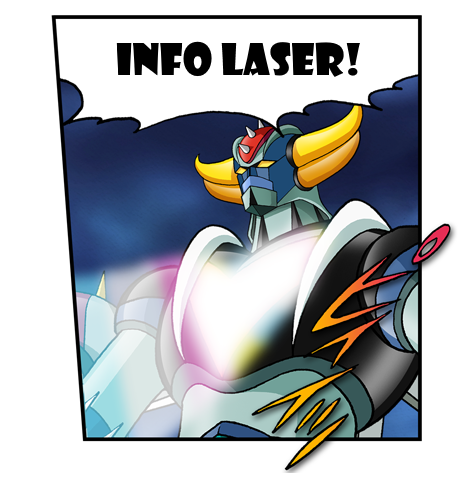We have already explained that the game is based on our Revolution D100 game engine. It is a variant of classic percentile RPGs, where you have abilities like Strength, Intelligence, etc., but you also have skills and you must roll a percentile die under your skill score to succeed. However, creating an RPG is not just choosing a play-tested game engine and sticking to it. Our game is for players who want to take parts in adventures “like Go Nagai would write them”. This does not mean that everything is pre-determined, and in fact you are free to choose the ending you like for your stories (anyone wishing for a different ending for Grendizer, perchance?). But whatever story you tell, it must sound like Mazinger, not Star Trek.
Thus, we had to make sure that the game encourages you to create Mazinger-like stories. In an RPG, a story is something you create at the table, not what the Narrator decided beforehand, so the rules should reward all players for acting like heroes in a Go Nagai series. Moreover, the outcome of actions should be the same they would have in the anime, rather than what would happen in classic roleplaying games.
But what is so unique in Go Nagai’s robotic tales? There are two key peculiarities: how they handle confrontation and battle, and how they represent heroism. In this article we will focus on the first and leave the second for another episode.
Confrontation
Confrontation is the moment when the heroes face a hostile opposition trying to frustrate their plans or to crush them outright, physically or morally. In Go Nagai’s stories, heroes face several kinds of challenges: finding missing people in a storm, persuading the United Nations not to surrender to the bad guys, infiltrating enemy bases or discovering enemy infiltrations into their own, designing and building new modules for vehicles, and, of course, fighting the minions of evil with both fists and beam guns. However, these challenges may look dangerous, but they are hardly ever deadly. Victory or failure in a confrontation determines whether the events follow the heroes’ plans or the bad guys’ machinations, but when someone passes away there are usually vehicles involved, even when the victim was not in one. It makes the demise of an important character more heroic.
Luckily, our game engine already manages these kinds of challenges in the correct way. Revolution D100 has a Conflict System that handles any kind of climactic scene by using “narrative hit points” based on characters’ abilities and rolling dice against their skills to inflict “narrative damage”, which the players describe in detail as the scene unfolds.
We will handle combat among humans in this way, too. Characters engaged in man-to-man combat suffer narrative “hits” rather than physical damage. Once the fight is over the losing party may decide that the character died, if it is dramatically appropriate, or that another kind of defeat took place, and the risk of death is postponed until a robot battle takes place.
Battle
Battle is something that happens between two or more giant, samurai-like robot warriors, and is a matter of power and heroism, not stealth and tactics like in real-world warfare or in realistic robotic anime. Some games make combat “narrative” in the same way we handle generic confrontations, but in a context where technical mecha details are often described in detail or even pictured, reducing robot battles to a “let’s narrate it” just did not feel right. Unrealistic as it is, robot combat is internally consistent in Go Nagai’s stories. We needed rules that yield precise results, leaving little room for interpretation.
Luckily, the Advanced Combat rules of Revolution D100 can handle this: combat is detailed, blows are location-based, armour can negate certain hits but not others, and heads and limbs fly off in quantities. We had to introduce some tweaks (such as removing the rules for taking cover, which never happens in super robot battles even if it is paramount in real warfare) but in the end we found that the core concepts were up to the job.
Weapon variety
While robot battles are heavily ritualised affairs, there are no “final weapons” in Mazinger. This feature, which is prevalent in later robotic anime, is almost absent from Go Nagai’s tales. Yes, some weapons are more powerful than others, but all are deadly, so we must make players use all weapons and not just the best ones. Note also that in super robot anime weapons have no “cooldown” time like you find in many computer games, so we had to discard this solution in order to keep the right atmosphere in combat.
In the end, reproducing the effects that weapons have in the anime was enough. Some weapons are more “tactical” in that they put the enemy at a temporary disadvantage, and others are more incline to dealing a crippling of finishing blows. Revolution D100 represents this very well with Readiness and Toughness, as you can use lesser weapons to decrease your opponent’s Readiness until you drop it to zero and go for a stronger attack to overcome Toughness. Giving armour the ability to “absorb” some kinds of energies like heat or electricity also helped to ensure that no “ultimate” weapon existed, and to produce those “oh no it had no effect” moments that often happen in the series.
We also added a further incentive to weapon variety by giving a Karma bonus to the first use of a weapon. But this is about Karma, so we will talk about this in a future article.
Mazinger Z, Great Mazinger, Getter Robot G, UFO Robot Grendizer and Kootetsu Jeeg are © Go Nagai / Dynamic Planning. Their likeness is used under license. Artwork by Kazuhiro Ochi.







